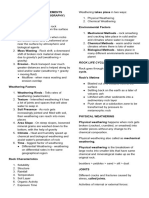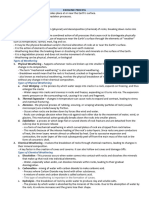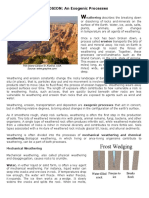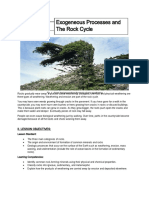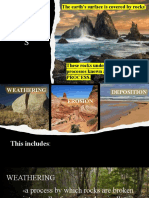0 ratings0% found this document useful (0 votes)
56 viewsExogenic Processes
Exogenic Processes
Uploaded by
Eunice Barcenas1) Thermal expansion occurs when rocks are exposed to high temperatures, causing their outer layers to expand and contract as they heat up and cool down, resulting in cracking and exfoliation.
2) Various natural and human processes can contribute to mechanical weathering, including burrowing animals, thermal expansion, exfoliation, frost wedging, root wedging, salt wedging, and human activities like digging.
3) Chemical weathering processes include dissolution, hydrolysis, oxidation, hydration, and biological weathering, which break down rock materials through chemical reactions and cause the formation of clay minerals and other products.
Copyright:
© All Rights Reserved
Available Formats
Download as DOCX, PDF, TXT or read online from Scribd
Exogenic Processes
Exogenic Processes
Uploaded by
Eunice Barcenas0 ratings0% found this document useful (0 votes)
56 views4 pages1) Thermal expansion occurs when rocks are exposed to high temperatures, causing their outer layers to expand and contract as they heat up and cool down, resulting in cracking and exfoliation.
2) Various natural and human processes can contribute to mechanical weathering, including burrowing animals, thermal expansion, exfoliation, frost wedging, root wedging, salt wedging, and human activities like digging.
3) Chemical weathering processes include dissolution, hydrolysis, oxidation, hydration, and biological weathering, which break down rock materials through chemical reactions and cause the formation of clay minerals and other products.
Copyright
© © All Rights Reserved
Available Formats
DOCX, PDF, TXT or read online from Scribd
Share this document
Did you find this document useful?
Is this content inappropriate?
1) Thermal expansion occurs when rocks are exposed to high temperatures, causing their outer layers to expand and contract as they heat up and cool down, resulting in cracking and exfoliation.
2) Various natural and human processes can contribute to mechanical weathering, including burrowing animals, thermal expansion, exfoliation, frost wedging, root wedging, salt wedging, and human activities like digging.
3) Chemical weathering processes include dissolution, hydrolysis, oxidation, hydration, and biological weathering, which break down rock materials through chemical reactions and cause the formation of clay minerals and other products.
Copyright:
© All Rights Reserved
Available Formats
Download as DOCX, PDF, TXT or read online from Scribd
Download as docx, pdf, or txt
0 ratings0% found this document useful (0 votes)
56 views4 pagesExogenic Processes
Exogenic Processes
Uploaded by
Eunice Barcenas1) Thermal expansion occurs when rocks are exposed to high temperatures, causing their outer layers to expand and contract as they heat up and cool down, resulting in cracking and exfoliation.
2) Various natural and human processes can contribute to mechanical weathering, including burrowing animals, thermal expansion, exfoliation, frost wedging, root wedging, salt wedging, and human activities like digging.
3) Chemical weathering processes include dissolution, hydrolysis, oxidation, hydration, and biological weathering, which break down rock materials through chemical reactions and cause the formation of clay minerals and other products.
Copyright:
© All Rights Reserved
Available Formats
Download as DOCX, PDF, TXT or read online from Scribd
Download as docx, pdf, or txt
You are on page 1of 4
Earth Science Thermal Expansion
Exogenic Processes Occurs when rock is exposed to high
temperature such as forest fire; its
Interconnected with the atmosphere,
outer layer expand due to baking.
hydrosphere, and biosphere.
When it cools, the outer layer
Include the processes of weathering
contracts, causing the surface to
erosion, transportation and
break-off into sheets.
deposition.
Primary source is the energy coming Burrowing Animals
from the sun which drives the
Can also push open cracks and move
weather.
rock fragments
Weathering
Human Activities
On-site breakdown of rocks and its
Such as digging and blasting
eventual transformation into
sediments Chemical Weathering
Mechanical and Chemical
Weathering Occurs when there are chemical
changes in at least some of the
Mechanical Weathering composition of the rock
1. Dissolution
Physical breakdown of a rock into
Happens in certain minerals which
unconnected grains or chunks
are dissolved in water. Halite (NaCl)
without changing its composition
dissolves rapidly in pure water, while
calcite (CaCO,) dissolves rapidly in
acidic water like rainwater.
Limestone, which is composed of
calcite, is weathered through this
Exfoliation process and develops caves through
time.
Natural cracks or joints are formed, 2. Hydrolysis
breaking the rock into rectangular Occurs when water reacts which the
blocks or irregular chunks or onion- minerals and breaks them down. The
like sheets. process occurs faster in slightly
Frost Wedging acidic water.
The common rock-forming minerals
In temperate regions or high-altitude like amphibole, pyroxene, and
regions, water inside the fractures of feldspar all react with water and
rocks experience regular freezing form various types of clay minerals
and thawing. 3. Oxidation
When it freezes, it causes the joints Or the reaction of oxygen with
to expand and grow, causing pieces minerals in the rock, forms oxides.
of rocks to detach. Oxidation of iron-bearing minerals
Root Wedging like biotite and pyrite produce iron
oxide (hematite) and iron hydroxide
Joints also expand when plants (goethite).
growing on its surface pry it open. 4. Hydration
Salt Wedging Occurs when water is absorbed into
the crystal structure of the mineral,
In deserts and coastal areas, salt
causing it to expand. Certain types of
solutions from groundwater or form
clay expand through this process.
the sea spray can accumulate in the
5. Biological Weathering
pore spaces and fractures of rocks.
When the salt crystalizes, it pushes Also occurs in roots of plants, when
apart the surrounding grains and fungi and lichens secrete organic
weakens the rock, causing it to acids that dissolve minerals and the
disintegrate when exposed to wind or nutrients are taken in by these
rain. organisms. There are also certain
bacteria that consume certain 1. Relief -The difference in elevation
minerals between two places creates slopes;
gravity pulls materials at higher
Transport
elevations to lower elevations
Involves processes by which 2. Slope stability -The balance
sediments are moved along from the between the downslope force caused
source to where they are deposited. by gravity and the resistance force
due to friction; slope failure occurs
Erosion
when the downslope force is greater
The separation and removal of 3. Fragmentation and weathering -
weathered and unweather rocks and Intact rock is held together by
soil from its substrate due to gravity chemical bonds within minerals, by
or transporting agents like wind, ice, mineral cement, and by the
or water. It involves abrasion, interlocking of grains, while a
plucking, scouring, and dissolution. fragmented rock is held only by
friction between fracture planes or by
Wind Erosion weak electrical charges between
Commonly occurs in flat, bare areas grains.
or dry, sandy, and loose soils Occurrence of mass wasting
It detaches soil particles and
transport them by wind 1. Vibrations from earthquakes or
Sandstorm blasting activities
2. Changes in the slope angle, load and
Glacier
slope support add to the instability of
A permanent body of ice, which a slope.
consists largely of crystallized snow 3. The stability of slopes also depends
and shows evidence of movement on the composition of the materials.
due to gravity.
Classification of Mass wasting
Glaciers have enormous erosive
power Can be classified in a number of
Water ways such as type of material, type
of motion, and speed of movement.
The most common erosion agent. In general, the types of material
Millions and tons of sediments are include rock and soil. Predominantly
picked up and transported every day coarse soil materials are called
along rivers, coasts, and in deep debris, while predominantly fine
oceans around the world materials are labeled as earth.
4 ways of water erosion
The general types of motion include
fall, topple, slide, spread, and flow
1. Traction – rolling or dragging of
large grains aided by the push of Fall
smaller grains. Includes the free-fall movement,
2. Saltation – bouncing of sand grains bouncing, and rolling of materials on
as they are picked up, carried along, a slope.
and dropped repeatedly.
3. Suspension – movement of fine Topple
particles like silt and clay The forward rotation out of the slope
4. Solution – movement of soluble of a soil or rock mass. The rotation
minerals (salt) axis is usually at the base of the
Mass wasting/mass movement moving mass, below its center of
gravity.
The downslope movement of rock,
soil, and ice due to gravity. Slide
It is also a natural hazard that can The downslope movement of
cause damage to life and property coherent materials along a well-
Factors in mass wasting
defined surface of rupture called Glacial environments refer to areas
sliding surface. where glaciers and ice sheets are
A slide could form a planar or curve found such as in high-altitude
sliding surface. Mountains and in Polar Regions.
Spread At the end of the glacier, a pile of
clay to boulder-sized sediments
The lateral extension and fracturing called glacial till can be found.
of a coherent mass due to the plastic
flow of its underlying material. Mountain stream Environment
This could occur as silt layers liquefy Turbulent streams can carry large
during earthquake. sediments like boulders and cobbles
Flow during flood, forming thick layers of
gravel and boulders.
Happens when the material are Conglomerates usually form in this
saturated and move downslope as environment.
viscous fluid.
Mountain front environment
Complex
When a stream enters the flat area at
Combinations of several types of the base of a mountain, it loses its
movement could occur. energy and decreases in velocity.
Deposition This process creates an alluvial fan, a
landform primarily composed of
The process in which sediments sand- to boulder-sized sediments.
settle out of the transporting
medium. Desert Environment
Bed Wind carries sand and silt materials.
When deposited, well-sorted sand
The layer formed when the materials
produces sand dunes, while the
are laid down.
accumulation of silts forms foes
Sorting deposit.
Sediments from solutions called
The distribution of grain size in a
evaporites are also formed when
layer.
temporary lakes in the desert dry-up.
Well-Sorted
Lake (Lacustrine) environment
Bed consists only of one or two
A lake is a quiet environment.
similar grain size
Streams carrying sediments deposit
Clay-size coarse sediments on lake margins,
only silt and clay are deposited from
Consists of a mixture of a very fine suspension in deeper parts of the
grain size lake.
Boulder-size Shale can form in this environment.
Consists of a mixture of a very River (Fluvial) Environment
coarse grain size
In flat areas, rivers are slow moving
Clasts and commonly carry an assortment
of pebbles, sand, silt, and mud. The
Larger sediments coarser sediments tumble along the
Matrix river bed, while the finer ones move
along in suspension.
Fine-grained sediments
Mud is deposited on the floodplain
Sedimentary Environment after food events.
Pebbles and sand are deposited on
Are where sediments are deposited
the inner bend of a meander.
Glacial Environment
Beds of sand and pebble form lenses Turbidity currents carry the finer
alternating with silt and mud layers sediment components, ranging from
sand to clay to a submarine fan
where turbidite deposit/sequence is
Delta Environment formed. In the deep ocean floor, clay
and planktons settle down and form
When a river enters the sea, it very thin layers of mud.
empties its load in a delta, which Chalk is formed from very fine
extends to the shallow coastal area. calcite shells, while chert is derived
The upper part of the delta consists from siliceous shells
mostly of coarse sand and gravel;
Cementation
the middle portion contains fine sand
and silt; The process which binds together the
And the basal portion is mostly silt individual grains.
and clay.
Cement
Mud is also found in the swamps
New minerals that is formed by
Beach Environment
dissolved chemicals in the water
Tidal currents transport sands along occupying the pore spaces in
the coastline. between grains.
The waves winnow out the finer Diagenesis
sediments, leaving only well-sorted
and well-rounded sand grains that The process of compaction,
form ripples. cementation, and recrystallization
Shallow marine environment
The mud and silt removed from the
shoreline and from river mouths are
transported by tidal currents and
deposited in quieter waters below the
wave zone.
It forms well-sorted and well-
rounded silt and mud layers
inhabited by various organisms like
worms and mollusks
Shallow water carbonate environment
In shallow marine environment
where the supply of sediments is
limited, marine, organisms like coral
reefs develop where the water is
fairly warm, clear, and full of
nutrients.
Most of the sediments are derived
from the shell and coral fragments,
which are collectively called
carbonate sediments.
Limestone can be formed in this
environment.
Deep marine environment
Slope failures from the steep slopes
of submarine canyons generate
submarine landslides which create
sediments of varying sizes.
You might also like
- Metamorphic, Igneous and Sedimentary Rocks : Sorting Them Out - Geology for Kids | Children's Earth Sciences BooksFrom EverandMetamorphic, Igneous and Sedimentary Rocks : Sorting Them Out - Geology for Kids | Children's Earth Sciences BooksNo ratings yet
- Earth Science ReveiwerDocument7 pagesEarth Science ReveiwerKrisha Mabel TabijeNo ratings yet
- Earth ScienceDocument8 pagesEarth ScienceRangerbackNo ratings yet
- Earth Science 11 M1 Quarter 2Document3 pagesEarth Science 11 M1 Quarter 2peanutNo ratings yet
- Q2-W1 WeatheringDocument60 pagesQ2-W1 Weatheringlacaron.kurtalexanderNo ratings yet
- G8 OutlineDocument4 pagesG8 OutlineSHARAINE PRINCESS CASTILLONo ratings yet
- For NTBK Q2 EarthSciDocument11 pagesFor NTBK Q2 EarthSciTrishia Lane GarciaNo ratings yet
- Earth Science ReviewerDocument22 pagesEarth Science ReviewerPatrick John Delfin BaydoNo ratings yet
- WeatheringDocument12 pagesWeatheringachyutchetia0No ratings yet
- WEATHERINGDocument3 pagesWEATHERINGZylla Athea TumamposNo ratings yet
- Unit 2 Endogenic Exogenic ProcessesDocument67 pagesUnit 2 Endogenic Exogenic Processeschristy janioNo ratings yet
- Earth Science ReviewerDocument9 pagesEarth Science ReviewerRod Raymond EjadaNo ratings yet
- EARTH SCIENCE Q2 Semester 1Document3 pagesEARTH SCIENCE Q2 Semester 1Zhe VenturozoNo ratings yet
- Earth & Life Science Week 5 Handouts Exogenic ProcessesDocument2 pagesEarth & Life Science Week 5 Handouts Exogenic ProcessesBenj Jamieson DuagNo ratings yet
- Eal Module 2Document7 pagesEal Module 2Angelina Jolai CentenoNo ratings yet
- Exogenic Processes: Earth & Life Science Week 5 HandoutsDocument2 pagesExogenic Processes: Earth & Life Science Week 5 HandoutsBenj Jamieson DuagNo ratings yet
- Chapter 6Document3 pagesChapter 6Xiao ZenNo ratings yet
- SEDIMENT & SEDIMENTARY ROCK GeologyDocument40 pagesSEDIMENT & SEDIMENTARY ROCK GeologyLionel MessiNo ratings yet
- MathematicsDocument4 pagesMathematicsJaykuNo ratings yet
- Earth Science Quarter 2 Module 1Document4 pagesEarth Science Quarter 2 Module 1Rhianne Grace CastroNo ratings yet
- Eart Sci q2 Part 1Document4 pagesEart Sci q2 Part 1Hannah VillocenoNo ratings yet
- Weathering and Mass Wasting Part 1Document35 pagesWeathering and Mass Wasting Part 1Muhammad AwatifNo ratings yet
- Earth Science Reviewer (FINALS)Document7 pagesEarth Science Reviewer (FINALS)athy3456No ratings yet
- Earth ScienceDocument14 pagesEarth ScienceSan Vicente West Calapan CityNo ratings yet
- 5 Sedimentary Rocks and WeatheringDocument9 pages5 Sedimentary Rocks and Weatheringshain begumNo ratings yet
- WeatheringDocument6 pagesWeatheringRobert TampusNo ratings yet
- 2.3-4 Exogenic ProcessesDocument1 page2.3-4 Exogenic ProcessesShelah Mae Crespo CooNo ratings yet
- Mr. Adryan J. ValiaoDocument60 pagesMr. Adryan J. ValiaoBenj Jamieson Duag100% (1)
- earthsci reviewerDocument5 pagesearthsci reviewerMarian Althea OftanaNo ratings yet
- Exogenic Process EalsDocument4 pagesExogenic Process EalsSamantha EspinoNo ratings yet
- Exogenic Processes (Grade 11)Document1 pageExogenic Processes (Grade 11)Kristhia Cyra RiveraNo ratings yet
- Earthscience Q2 G11Document8 pagesEarthscience Q2 G11jerahmiyah23No ratings yet
- Earth Science by Erna Mae NarcisoDocument3 pagesEarth Science by Erna Mae NarcisoNarciso, Erna Mae B.No ratings yet
- Grade 11 Earth Science ReviewerDocument7 pagesGrade 11 Earth Science ReviewerIssa Belle Tuson0% (1)
- Earth and Life Science ReviewerDocument9 pagesEarth and Life Science ReviewerHannah Joy DagdagNo ratings yet
- WEATHERING AND EROSION: An Exogenic Processes: Eathering Describes The Breaking DownDocument8 pagesWEATHERING AND EROSION: An Exogenic Processes: Eathering Describes The Breaking Downivan pesebreNo ratings yet
- مؤمل علي محسن - صباحي - تقرير١Document14 pagesمؤمل علي محسن - صباحي - تقرير١مؤمل علي محسن منشدNo ratings yet
- Unit 3 Weathering Erosion Mass WastingDocument6 pagesUnit 3 Weathering Erosion Mass WastingMandora SGNo ratings yet
- Geology - Lecture 2.1Document20 pagesGeology - Lecture 2.1omay12No ratings yet
- Weatheri NG: University of Zakho College of Engineering Petroleum Engineering DeparmentDocument33 pagesWeatheri NG: University of Zakho College of Engineering Petroleum Engineering DeparmentLulav BarwaryNo ratings yet
- PDF 20230102 223554 0000 PDFDocument16 pagesPDF 20230102 223554 0000 PDFJay-Em SingsonNo ratings yet
- Earth-scieDocument5 pagesEarth-scieArham GutocNo ratings yet
- There Are Four Types of WeatheringDocument2 pagesThere Are Four Types of WeatheringBeyoung GamefightNo ratings yet
- Earth Sci Reviewer q2 3Document5 pagesEarth Sci Reviewer q2 3machiruu002No ratings yet
- Earth and Life ScienceDocument14 pagesEarth and Life ScienceKaren DedulloNo ratings yet
- Social Science Grade 9 Term 3 NotesDocument21 pagesSocial Science Grade 9 Term 3 NotesShurayhNo ratings yet
- Geography Notes - Weathering and RocksDocument9 pagesGeography Notes - Weathering and RocksMaster T100% (1)
- GEOLOGIC PROCESSES ON EARTH (Exogenous Processes)Document4 pagesGEOLOGIC PROCESSES ON EARTH (Exogenous Processes)Donna Mae AbonalNo ratings yet
- Es 2ND Week1Document12 pagesEs 2ND Week1Isaiah Timothy RabangNo ratings yet
- Weathering. Media and HalatDocument26 pagesWeathering. Media and HalatSoma BerwariNo ratings yet
- Exogenic Process HandoutsDocument6 pagesExogenic Process HandoutsMG GadonNo ratings yet
- Weathering and Erosion, What It Is and Types.Document19 pagesWeathering and Erosion, What It Is and Types.MahirNo ratings yet
- ROCKSDocument40 pagesROCKSAngelica Mae PartosaNo ratings yet
- Earth-and-Life-Science-Module 2Document10 pagesEarth-and-Life-Science-Module 2Nagum RhianneNo ratings yet
- 018 Weathering GeofactsheetDocument2 pages018 Weathering Geofactsheetbarrybogs19No ratings yet
- Exogenic ProcessesDocument19 pagesExogenic ProcessesMARIA LOURDES MENDOZA100% (1)
- Exogeneous Processes and The Rock Cycle: Ii. Lesson ObjectivesDocument9 pagesExogeneous Processes and The Rock Cycle: Ii. Lesson ObjectivesRiguel Jameson AllejeNo ratings yet
- Lecture#05Document18 pagesLecture#05jimmy mainaNo ratings yet
- HANDOUT NO5 - ElsDocument2 pagesHANDOUT NO5 - ElsJeandale VargasNo ratings yet
- EGEO1Document5 pagesEGEO1.....No ratings yet
- WMD2020Document265 pagesWMD2020Md HabibNo ratings yet
- Properties of Fresh Concrete: Course Content (2) - Module 2 (6 HRS)Document49 pagesProperties of Fresh Concrete: Course Content (2) - Module 2 (6 HRS)Pramod SahNo ratings yet
- Fluid: Continuum MechanicsDocument3 pagesFluid: Continuum MechanicsAnonymous QM0NLqZONo ratings yet
- A Presentation On NDTDocument23 pagesA Presentation On NDTBipin ShresthaNo ratings yet
- App5 - EC2 Design PDFDocument70 pagesApp5 - EC2 Design PDFrenzo1221No ratings yet
- CMT Electronic Heated ViscometerDocument1 pageCMT Electronic Heated ViscometerIBRAHIM ALMANLANo ratings yet
- Chapter 4 Magnetic CircuitsDocument60 pagesChapter 4 Magnetic CircuitskkNo ratings yet
- Structure and Elastic Properties of Quartz at PressureDocument11 pagesStructure and Elastic Properties of Quartz at PressureFernanda GuterresNo ratings yet
- ChemistryQB Topic9c SQ eDocument16 pagesChemistryQB Topic9c SQ eDacy ChowNo ratings yet
- Bartl Ipsmiller 2023 Fast Fashion and The Circular Economy Symbiosis or AntibiosisDocument2 pagesBartl Ipsmiller 2023 Fast Fashion and The Circular Economy Symbiosis or AntibiosisMaghfira Rizky Maulani S.AB.,MMNo ratings yet
- Complex Formation Between Iron (III) and Isonicotinohydroxamic Acid and Its Microbial Studies A.O. Aliyu and J.N. NwabuezeDocument8 pagesComplex Formation Between Iron (III) and Isonicotinohydroxamic Acid and Its Microbial Studies A.O. Aliyu and J.N. NwabuezeGINA PAOLA BERRÍO JULIONo ratings yet
- Astm A-572Document5 pagesAstm A-572Wanderley CardosoNo ratings yet
- Table NPS From API 574 2016Document6 pagesTable NPS From API 574 2016ainunNo ratings yet
- Brønsted Concept of Acids and BasesDocument4 pagesBrønsted Concept of Acids and Basescayla mae carlosNo ratings yet
- Astm A 416 A 416 M - 16Document5 pagesAstm A 416 A 416 M - 16ipkm123100% (2)
- A Case Study On Pre-Tensioning & Post Tensioning Systems of A Prestressed ConcreteDocument6 pagesA Case Study On Pre-Tensioning & Post Tensioning Systems of A Prestressed ConcreteSHEKHARNo ratings yet
- A Study of Concrete Paver Block Using Crumb Rubber in InterlockingDocument4 pagesA Study of Concrete Paver Block Using Crumb Rubber in InterlockingEditor IJTSRDNo ratings yet
- Nozzlepro 4: Paulin Research GroupDocument6 pagesNozzlepro 4: Paulin Research Grouprishit_aNo ratings yet
- TekstDocument83 pagesTekstAdnan MujkanovicNo ratings yet
- 6 Duct Systems.Document12 pages6 Duct Systems.akahayNo ratings yet
- Nanoparticulate Drug Delivery System: Mr. Sagar Kishor SavaleDocument101 pagesNanoparticulate Drug Delivery System: Mr. Sagar Kishor SavaleHemin H. MuhammadNo ratings yet
- Bastani UV Curable Powder Coatings Containing Interpenetrating Polymer Networks IPNs Progress in Organic Coatings 2006-56-248Document4 pagesBastani UV Curable Powder Coatings Containing Interpenetrating Polymer Networks IPNs Progress in Organic Coatings 2006-56-248andreathomeNo ratings yet
- EMT04R57 - Characteristics of Electrolytic Zinc Plate - Trivalent ChromateDocument2 pagesEMT04R57 - Characteristics of Electrolytic Zinc Plate - Trivalent ChromateAleks SenaNo ratings yet
- PervaporationDocument18 pagesPervaporationKaustubh Dhabale50% (2)
- Caddx Baby Turtle V2 Nano 1080p 60fps Mini HD FPV Camera With DVRDocument4 pagesCaddx Baby Turtle V2 Nano 1080p 60fps Mini HD FPV Camera With DVRTiar AgustiantoNo ratings yet
- Problem Solving: Dr. Saima Shabbir, MSE, ISTDocument15 pagesProblem Solving: Dr. Saima Shabbir, MSE, ISTOsama Aadil SaadiNo ratings yet
- Physics PlanDocument1 pagePhysics Plansophisticatedsage06No ratings yet
- Tablas Nec InglesDocument24 pagesTablas Nec InglesJavier Encalada100% (1)
- Appc Soil Properties 718Document5 pagesAppc Soil Properties 718pinkuru100% (1)
- Flame PhotometerDocument5 pagesFlame PhotometerسيليناNo ratings yet





